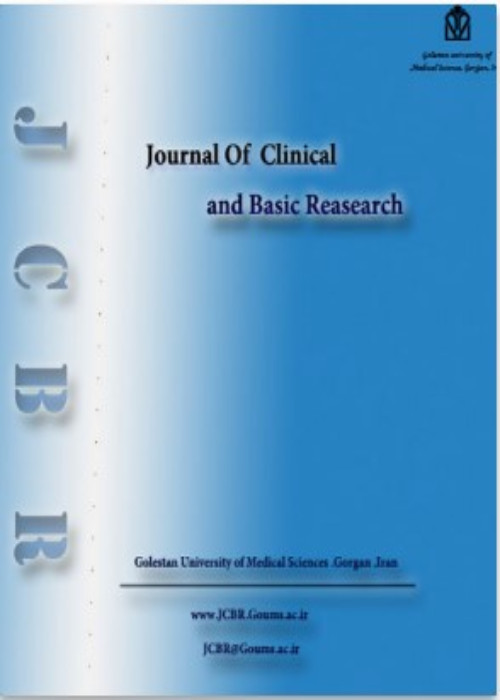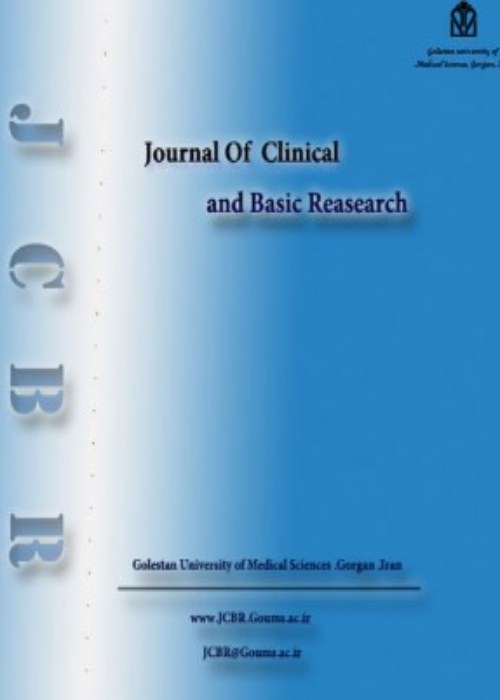فهرست مطالب

Journal of Clinical and Basic Research
Volume:7 Issue: 2, Spring 2023
- تاریخ انتشار: 1402/07/17
- تعداد عناوین: 6
-
Pages 1-4Background
In cases of chronic otitis media (COM) presenting with unilateral squamosal disease, there may be the possibility of a potential disease in the opposite ear, which may lead to future complications. Therefore, it needs to be known whether there is any silent pathological process in the contralateral ear (CLE) that is currently asymptomatic but likely to be diseased in the near future. Therefore, this study was undertaken to analyze the fate of the contralateral asymptomatic ear in patients with unilateral squamosal disease.
ResultsA total of 32 patients with COM squamosal disease were included. All the patients were subjected to clinical examination and a high-resolution computed tomography (CT) scan of bilateral temporal bones. The mean duration of age at presentation was 20.4 years. The male-to-female ratio was 1.28. Out of 32 patients, 11 (34%) showed either clinical or radiological findings in the asymptomatic CLE, out of which 7 showed both abnormal clinical and radiological findings, 3 demonstrated only abnormal clinical findings, and 1 showed only abnormal CT changes without obvious clinical findings in the CLE. In the CLE, 7 (21%) patients had mild conductive hearing loss. There was no statistically significant association of clinical findings or radiological findings in CLE to that of the unilateral squamosal diseased ear.
ConclusionIn cases with unilateral squamosal disease, an asymptomatic CLE can undergo subclinical changes and conductive hearing loss. Patients can also have silent radiological changes in the CLE detected on the CT scan, which are significant but remain undetected. No statistical significance could be reported in this study, yet other studies with even larger samples are required to show a causal relation between unilateral squamosal disease and a quiescent process in the asymptomatic CLE.
Keywords: Unilateral squamosal disease, Ear diseases, Asymptomatic diseases -
Pages 5-7Background
HER2/neu is associated with increased tumor grade, and Ki-67 is related to tumor recurrence and stage progression. This study aims to evaluate the clinical profile in patients with urothelial neoplasms and correlate the expression of HER2/neu and Ki-67 in urothelial carcinomas.
MethodsThis is a five-year retrospective study from June 2017 to May 2022 with forty cases from the Department of Pathology. A microscopic examination was done to assess the tumor stage and histological grade. Immunohistochemistry was performed with HER2/neu and Ki-67.
Results65% (26/40) of the cases were diagnosed as infiltrating urothelial carcinoma, 30% (12) of the cases as low-grade non-invasive urothelial carcinoma, one case as a papillary urothelial neoplasm of low malignant potential (PUNLMP), and one case as urothelial papilloma. 95.5% of infiltrating carcinomas and 84.5% of low-grade non-invasive carcinomas were Ki-67-positive. A significant correlation was observed between the expression of Her-2/neu and Ki-67 and the 2016 World Health Organization (WHO) grading system of urothelial carcinoma. Moderate-to-strong HER2/neu overexpression (2+ or 3+) was observed in only 18% of cases.
ConclusionThe expression of ki-67 increased with an increase in the grade of tumor, which shows its prognostic importance. The relation between Ki-67 expression and the histologic grade of the tumor and the presence of lymphovascular invasion was significant. A significant correlation was observed between the grade of the carcinoma and the immunohistochemical expression of HER2/neu, in which 19.3% of high-grade carcinoma cases showed immunohistochemical expression of the HER2/neu marker. Further studies with a larger population group are required to establish the role of HER2/neu as a prognostic marker.
Keywords: Her2, neu, Ki- 67, Urothelial neoplasms, Non-muscle invasive bladder neoplasms -
Pages 8-15Background
The root of Waltheria indica is used in Nigeria to enhance libido. This study evaluated the aphrodisiac potential and toxicological profile of ethanol root extract (EEWI) in male Wistar rats.
MethodsThe aphrodisiac potential was evaluated on the 7th and 14th days of oral administration of graded doses (100, 200, and 400 mg/kg/day) of EEWI. Anxiolytic properties were evaluated on the 7th day, while memory retention properties were evaluated on the 14th, 21st, and 28th days. Sperm parameters, toxicological profile, and antioxidant potential were evaluated on the 28th day. The in vitro antioxidant property was also evaluated.
ResultsIn a dose-dependent manner, the extract increased mounting frequency and intromission frequency but significantly decreased mount and intromission latencies (p<0.001) on the 7th and 14th day of treatment. It prolonged ejaculatory latency. Anxiolytic and memory studies showed that the extract compared agreed with standards. Toxicologically, it was observed that all the doses used neither caused death nor any gross toxicological symptom. A significant increase (p<0.05) was observed in the concentrations of catalase (CAT), superoxide dismutase (SOD), and glutathione peroxidase (GPX), as well as hematological parameters such as red blood cells and hemoglobin. A significant reduction in total sperm and motile sperm cell counts was observed in rats given the highest dose.
ConclusionThe extract possesses aphrodisiac action and is relatively safe. The antioxidant property may accentuate the aphrodisiac and anti-anemic use in ethnomedicine.
Keywords: Erectile dysfunction, Sexual behaviors, Antioxidant, Sperm, Toxicity -
Pages 16-20
In March 2020, the World Health Organization (WHO) announced that Coronavirus (2019) (COVID-19) was recognized as a global epidemic. In late 2019, a new type of the coronavirus family, known as Acute Respiratory Syndrome (SARS-CoV-2), emerged in Wuhan, China, and was named Covid-19. The COVID-19 epidemic has plunged the world into an unprecedented crisis, causing huge human and economic losses. As of July 6, 2020. The high rate of lung infection, long latency period, with mild to moderate symptoms or even cases that many people experience, or even cases of asymptomatic patients, has made Covid-19 a worrying disease. Challenges to treat the disease include vaccine design, high-speed mass production, and uniform worldwide distribution. Nanoparticles with their physicochemical properties can be a promising treatment method to win the battle against coronaviruses. Nanotechnology usually deals with the design and development of materials with dimensions of 1 nanometer to hundreds of nanometers, which makes it possible to design and manufacture materials with the desired structure and a controllable and small structure. In this review article, we explore the disease of Covid-19 and the potential of nanotechnology as a bright and promising pathway for the diagnosis, drug delivery, and treatment of Covid-19.
Keywords: Covid-19, Nanotechnology, Nanoparticles, Coronavirus, Covid-19 vaccine, Diagnosis -
Pages 21-25Background
Improper prescription of the type, dose, and duration of antibiotics imposes a financial burden on the health system, can cause many side effects for the patient, and can lead to the emergence of drug-resistant bacteria. This study aimed to determine the profile of prescribing antibiotics in different wards of a hospital and compare it with references.
MethodsThis study was conducted on the recorded information of 342 patients in the emergency, infectious diseases, pulmonary, and surgical wards of Sayad Shirazi Hospital in Gorgan (north of Iran) in 2019-2020. The type, dose, and duration of the prescribed antibiotics were extracted from each patient's file and compared with references. The compatibility and inconsistency of the prescribed antibiotics were identified and analyzed accordingly.
ResultsA total of 13 types of antibiotics were prescribed for the patients. There was a 43.7% inconsistency in antibiotic prescription with the references. The most prescribed antibiotic was ceftriaxone (25.6%). Ceftriaxone (11.26%), followed by cefazolin (8.30%), had the most inconsistency in prescription. The most inconsistency in total was respectively observed in the pulmonary (47.9%), general surgery (44.8%), emergency (44.4%), and infectious diseases wards (40.6%). No significant difference was observed between the wards in terms of the total inconsistency of prescribed antibiotics with the references (P = 0.692).
ConclusionThe most prescribed antibiotic was ceftriaxone. A high percentage of its prescriptions are without indication and are actually prescribed as empiric. Therefore, it is necessary to monitor the prescription of antibiotics in medical centers based on the indications and available evidence.
Keywords: Anti-Bacterial Agents, Drug Misuse, Ceftriaxone, Hospitals, Hospitalization -
Pages 26-29Background
Cervical cancer is the most frequent cause of death for women in developing countries. India, the second-most populous nation in the world, accounts for about 25% of cervical cancer deaths. Even in its premalignant stage, cervical cancer can be detected using a Papanicolaou (Pap) smear test.
The goal was to study the role of Pap smear in detecting premalignant, malignant, and non-neoplastic lesions of the cervix and to ascertain the frequency of different lesions.MethodsAll women who visited the obstetrics and gynecology outpatient department (OPD) at GMERS Medical College and Hospital, Navsari, India, in 1 year for different clinical problems were recruited. A total of 322 women who were sexually active and over 21 years of age were enrolled in the study. A Pap smear was used for all the women to screen for cervical cancer. The smear was obtained using an Ayre spatula and spread over a marked glass slide, which was placed in 95% ethyl alcohol and sent to the Department of Pathology for cytopathological examination. Women who had visible malignant cervical lesions were excluded. All the data were recorded in a predetermined form.
ResultsA total of 322 patients were screened. Out of 322, 261 smears were NILM (negative for intraepithelial lesion or malignancy) and 126 (39.1 %) smears had inflammatory changes; 2.2 % and 1.2% smears showed changes as ASCUS (atypical squamous cells of undetermined significance) and ASC-H (atypical squamous cells cannot exclude high-grade squamous intraepithelial lesions), respectively; 4.7 % and 5.3% smears showed LSIL (low-grade squamous intraepithelial lesion) and HSIL (high-grade squamous intraepithelial lesion). Squamous cell carcinoma was observed in only 2 (0.6%) of the smears. A total of 16 (4.9%) smears were unsatisfactory for evaluation because they lacked sufficient squamous components or were obscured by inflammation.
ConclusionThe Pap smear test is a very easy, non-invasive, useful, simple, safe, and economical tool to detect preinvasive cervical epithelial lesions. It is evident and proven that every woman above the age of 30–35 years must be subjected to cervical screening, and this must be continued even in the postmenopausal period.
Keywords: Uterine cervical neoplasms, Cytology, Papanicolaou test


